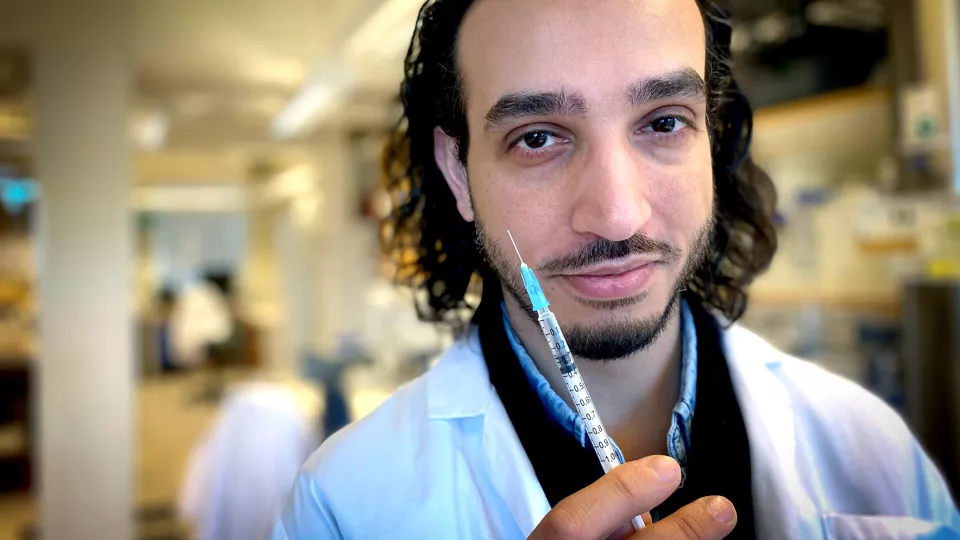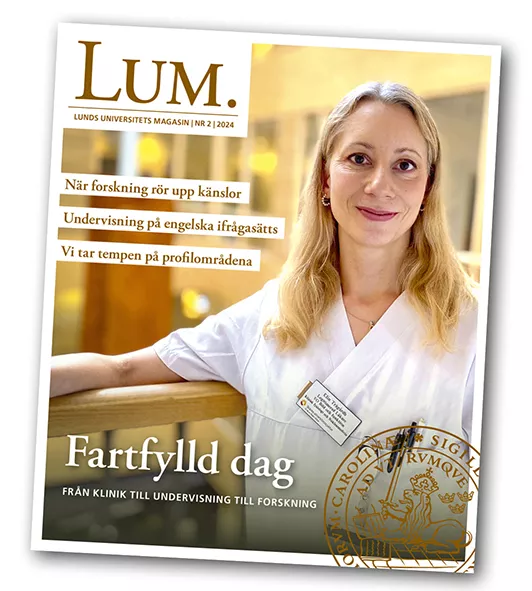A lot of the criticism against vaccines occurs on social media and the information is often emotional rather than based on facts from reliable sources. Many of Farshid Jalalvand's friends have got in touch and asked him about the Covid-19 vaccine and, when his article about narcolepsy and vaccines was published, many people wanted to interview him. Then the media cycle really kicked into gear.
He understands that people are afraid. Our brains are designed to register danger and link it to an event. The vaccine against swine flu came quickly and the often young people who got narcolepsy were strongly impacted. This makes it easy to generalise to the notion that the danger applies to all vaccines.
Out of almost six million Swedes who were given the Pandemrix vaccine against swine flu, 400 developed narcolepsy – i.e. 1 in 10 000. The vaccine was based on technology from the vaccine against seasonal flu, which is not tested like a normal vaccine – otherwise the season would be over before all the studies were completed."
To get narcolepsy requires a particular genetic make-up and scientists believe it was the virus component in the vaccine that caused people to become ill. This means that, if these people had caught swine flu, they would also have developed narcolepsy.
"It is not acceptable in any way and the vaccine against swine 'flu would never have progressed in a clinical trial if this had been suspected. But there is no general correlation between vaccines and danger. If you consider the whole picture, vaccines are safe, effective and help us to save lives."
Covid 19-vaccin in a short time due to luck
There are several factors behind the successful development of a Covid-19 vaccine in such a short time. In part, it is pure luck. When scientists are to produce a vaccine, they compare the various proteins on the virus's surface to see whether they resemble any other protein in the human body. They also test to ensure that the immune system reacts sufficiently. If it doesn't work with the first protein, they have to go back and choose another, continuing in this way until they find the right one. In this case, they immediately found the spike protein located on the surface of the Covid-19 virus, which worked very well. In addition, a lot of resources and money have been put into vaccine research, while the bureaucratic process around its development was given the highest priority.
"We were also lucky that the Covid-19 virus does not mutate to any high degree. If we had been dealing with Hepatitis C or HIV, we would never have been able to develop a vaccine so quickly".
Much higher number of people than usual in vaccination studies
The last stage of producing a functioning vaccine is to administer it to a group of people to see whether it has any effect and then compare the outcome with a group of equal size that has only been given a placebo. As it is unethical to actively infect people with Covid-19, people were simply left to live their lives, and then researchers looked at which group had most cases of disease. Just over 20 000 people were given the vaccine against Covid-19 and the same number were given a placebo. That is a much higher number of people than is usual in vaccination studies, which means that any side-effects will be much better traced. Because of the rapid spread of the pandemic, after little more than five weeks researchers already had the 150 cases that statisticians had determined would be a measure of significance. 140 people in the placebo group fell ill, against only 10 in the vaccination group. An effective vaccine had been developed. The most common side-effects, which disappeared after a few days, were pain at the injection site, tiredness, headache, muscular and joint pain, chills and fever. A few cases of more serious side-effects were reported and the Swedish Medical Products Agency Is now investigating whether these are linked to the vaccine.
"It is not surprising that you observe cases of illness when you are simultaneously monitoring the health status of tens of thousands of people, above all elderly vaccinated patients. If you compare that group with an equivalent unvaccinated group, you will most probably find a similar number of cases of disease."
"Having fun is not a right – there are no rights in nature."
Farshid Jalalvand has not met up with his friends for almost a year and his children have not been able to see their grandparents during the pandemic. Of course, the family finds this incredibly trying but, like most other people, they are doing what they can to limit the spread of infection. However, Farshid Jalalvand is surprised that some people refuse to accept restrictions on their lives. He thinks it is almost as though civilisation's progress has convinced us that we deserve our current existence.
"Our economic well-being has accustomed us to a relatively problem-free existence, with good health, good finances and rich leisure time. The pandemic is a reminder of our biological reality, that life cannot be taken for granted or guaranteed and it is not a party. Having fun is not a right, because there are no rights in nature."
It is not only the elderly and people with co-morbidities who have died of Covid-19. Young people with compromised immune systems have also died and paediatric ICUs are overstretched, with children who have caught the serious inflammatory disease MIS-C as a result of Covid-19 infection. In addition, public healthcare is overloaded, people's surgeries and check-ups are being cancelled and fewer cases of cancer are being diagnosed than normally. All resources are going to the pandemic.
"But the greatest threat is social unrest. It would have threatened the entire social structure if we hadn't had the restrictions that enable public healthcare to help those most in need."
Herd immunity is required to get over the pandemic and, to achieve it, we need enough people to get vaccinated.
"Otherwise the pandemic will persist – as will the restrictions. It is everyone's responsibility. That is how simple it is, and how hard", concludes Farshid Jalalvand.



